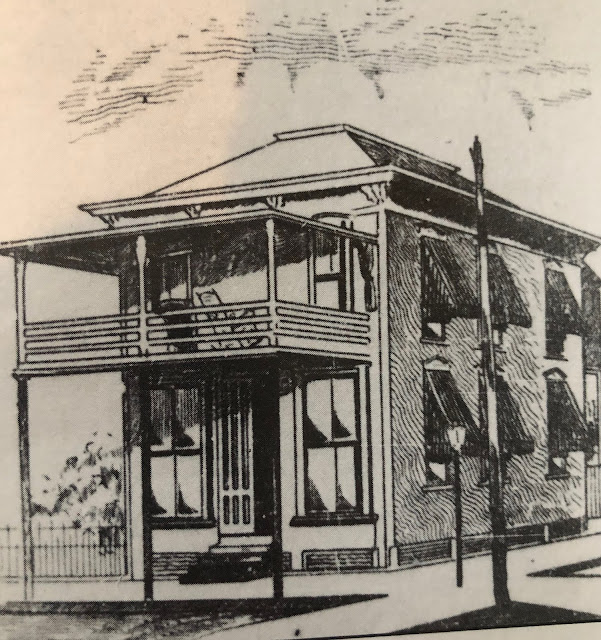Florida's 20th governor and one of the most famous residents of Punta Gorda was born in Greenwood, SC. His then-wealthy family traced descent from Presidents Washington and Madison. His life story was a real-life version of the classic 19th century fictional story of “Horatio Alger”, a boy who rose from poverty to wealth through a combination of hard work, self improvement, and determination. His varied career included work as a store clerk, railroad surveyor and civil engineer, military service, land development and citrus growing.
Mr. Gilchrist's parents owned large properties primarily in Quincy, FL (Gadsden County) at the time of his birth in 1858. His father's early death in 1860 from pneumonia coupled with the devastation of the Civil War and his family's poor management reduced Albert Gilchrist to relative poverty. He was forced to make his way from an early age, selling firewood at age nine and working as a store clerk for $15.00 per month.
His early education in local schools was followed by the Carolina Military Institute (Charlotte, NC) from which he graduated in 1877. In 1878 he won an appointment to the West Point Military Academy through a competitive exam. He attended West Point for three years but was “retired” from the school due to academic deficiencies. His primary difficulty was noted as being in “experimental philosopy”, a field of study not directly related to military science but then considered part of a rounded education.
Mr. Gilchrist returned to Florida and began his business career working as a civil engineer and surveyor in Gadsden County. He subsequently was employed by the Florida Southern Railroad as both a surveyor and civil engineer on their lines. Through this job he first came to Punta Gorda in 1885-1886. He saw a future in the rapidly growing town, left the railroad, and settled in the town. He began work on his own as a surveyor, land investor, and developer. His real estate business was profitable enough to become his full-time occupation and provided the funds for both additional land investments and eventually the addition of citrus growing to his activities.
He was also active in politics almost from the time he settled in Punta Gorda. Mr. Gilchrist was one of the voters who incorporated the town and then ran for mayor during the first election. He fell only two votes short of winning but remained determined to run for office again. He was first elected to the state legislature in 1893 and over the next 12 years was successful in rising to Speaker, the highest legislative position in the state. In all his races Mr. Gilchrist ran as a Democrat, which was almost a requirement for a successful political career in the South in the decades after the Civil War. However his legislative career was marked by his willingess and ability to work with opposition politicians to achieve mutual goals and by a personal warmth and openness which resulted in his having political opponents but no personal enemies, a remarkable achievement in any period.
In addition to his work in business and in politics Albert Gilchrist had a strong interest in military affairs, dating from his time at both Carolina Military Institute and the West Point Military Academy. He was active in the state militia, ultimately being appointed Brigadier General and Inspector General. In addition he was a member of the Board of Visitors at West Point and had the satisfaction of returning to West Point wearing a general's stars and being saluted by many of the professors who had participated in his “retirement” from the school. Despite his senior rank in the militia he enlisted as a private for the Spanish American War in 1898 and in 18 months of service (but no combat) achieved the rank of Captain.
He left the service in 1899, returned to business and in 1902 again ran for and was elected to the state legislature. In 1903 he ran for Speaker of the state legislature and was defeated, receiving only 2 votes, including his own. He remained determined not to give up and developed a reputation for efficiency, moderation, and successful compromise which resulted in his unanimous election as Speaker in 1905.
Mr. Gilchrist was by then a successful businessman, military veteran, and respected legislator. He ran for governor in 1908 and was easily elected. His campaign adopted the motto “Hear no evil, see no evil, speak no evil” to symbolize his refusal to run down his opponents and his willingness to work with all parties. His administration focused on developing public health and infrastructure projects designed to benefit all Floridians.
The governor's human side was marked by having his mother serve as “First Lady” during his term in part because of his affection for her and in part because he never married. Punta Gorda's children benefit to this day from another of his projects, which involved a bequest which created a trust which provides free ice cream to children at Gilchrist Park in town each Halloween. Numerous charities benefitted from his decision to leave his remaining, considerable estate to them.
Albert Gilchrist is remembered by historians as one of Florida's most effective governors. Because of his personal modesty and moderate approach to politics his reputation has been somewhat overshadowed by more flamboyant predecessors and successors. Governor Gilchrist died in New York City in 1926 following an operation. His body was returned to Punta Gorda for interment in Indian Springs Cemetery. He is memorialized by the southbound Route 41 bridge over the Peace River and by the creation of Florida's last county, which was named after him.
By Mark Surresco
Punta Gorda History Center




































